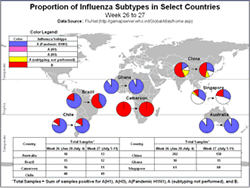2009 H1N1 Flu: International Situation Update
July 26, 2010, 1:00 PM ET
This report provides an update to the international flu situation using data collected through July 18, 2010, and reported by the World Health Organization (WHO) on July 23.
WHO continues to report laboratory-confirmed 2009 H1N1 flu deaths![]() on its Web page. These fatal cases are an under-representation of the actual numbers, as many deaths are never tested or recognized as flu related.
on its Web page. These fatal cases are an under-representation of the actual numbers, as many deaths are never tested or recognized as flu related.
In the Southern Hemisphere, respiratory disease activity has increased recently in some countries, including South Africa, New Zealand, and Australia. In the Northern Hemisphere, influenza detections have been limited.
Reports of respiratory disease have increased in South Africa in the last month, and most influenza-positive samples have been either seasonal B or A (H3N2) viruses. Similar increases have occurred in Australia, where 2009 H1N1 is the predominant virus strain. Chile has seen increases in respiratory activity in recent weeks, predominantly the result of respiratory syncytial virus. Influenza like illness (ILI) activity has increased in New Zealand in recent weeks, though activity is below the levels seen in 2008 and 2009.
Influenza-like illness has increased in recent weeks in Singapore with co-circulating 2009 H1N1 and seasonal A (H3N2) and B viruses detected. ILI activity has also increased in Cambodia. Influenza detections continue to occur in Africa, with 2009 H1N1 predominant in Ghana and seasonal B predominant in Cameroon.
Selected Highlights
- According to WHO, the majority of 2009 H1N1 virus isolates tested worldwide remains sensitive to oseltamivir, an antiviral medicine used to treat flu. Among 2009 H1N1 isolates tested worldwide, 302 have been found to be resistant to oseltamivir as of July 21st. Approximately 1% of U.S. 2009 H1N1 viruses tested by CDC since September 1, 2009, have been resistant to oseltamivir.
- The proportion of influenza viruses positive for seasonal B has decreased in China recently, from 56.9% of all influenza detections last week to 46.8 this week.
- On February 18, 2010, WHO published recommendations for the following viruses to be used for influenza vaccines in the 2010-2011 influenza season of the Northern Hemisphere:
- an A/California/7/2009 (H1N1)-like virus;
- an A/Perth/16/2009 (H3N2)-like virus*;
- a B/Brisbane/60/2008-like virus.
* A/Wisconsin/15/2009 is an A/Perth/16/2009 (H3N2)-like virus and is a 2010 Southern Hemisphere vaccine virus.
Health Organizations
- World Health Organization (WHO)
- ECDC (European Centre for Disease Prevention and Control)
- H2P (Humanitarian Pandemic Preparedness)
- Public Health Agency of Canada
World Health Organization (WHO) Regional Offices
- AFRO (WHO Regional Office for Africa)
- AMRO (WHO Regional Office for the Americas) / PAHO (Pan American Health Organization)
- EMRO (WHO Regional Office for the Eastern Mediterranean)
- EURO (WHO Regional Office for Europe)
- SEARO (WHO Regional Office for South-East Asia)
- WPRO (WHO Regional Office for the Western Pacific)
Travel and 2009 H1N1 Flu
Human cases of 2009 H1N1 flu virus infection have been identified in the United States and several countries around the world. For information on 2009 H1N1 flu and travel, see the CDC H1N1 Flu and Travel website.
Reports and Publications
- White House Report on 2009 H1N1 in the Southern Hemisphere
Issued August 2009 – This White House report was prepared by the Department of Health and Human Services (HHS) in coordination with the Office of the Director for National Intelligence (ODNI) and the Department of State (Dos) and describes the characteristics and impact of 2009 H1N1 influenza A virus in the Southern Hemisphere. - ECDC Interim Risk Assessment Influenza A (H1N1) 2009 Pandemic
Issued July 30, 2009 - This document provides an interim risk assessment of novel H1N1 flu in Europe prepared by ECDC. - World Health Organization Weekly Epidemiological record – Issued July 24, 2009
This document by WHO provides updates on the international novel H1N1 flu situation. - MMWR – Update: Novel Influenza A (H1N1) Virus Infection – Mexico, March-May, 2009 – Issued June 5, 2009 / Vol. 58 / No. 21.
This Morbidity and Mortality Weekly Report describes the novel influenza A (H1N1) outbreak in Mexico from March-May, 2009. - MMWR – Update: Novel Influenza A (H1N1) Virus Infections – Worldwide, May 6, 2009 – Issued May 8, 2009 / Vol. 58 / No. 17.
This Morbidity and Mortality Weekly Report describes worldwide novel influenza A (H1N1) infections as of May 6, 2009.
Get email updates
To receive weekly email updates about this site, enter your email address:
Contact Us:
- Centers for Disease Control and Prevention
1600 Clifton Rd
Atlanta, GA 30333 - 800-CDC-INFO
(800-232-4636)
TTY: (888) 232-6348 - Contact CDC-INFO
